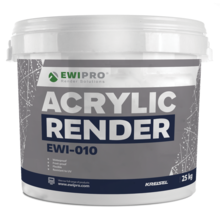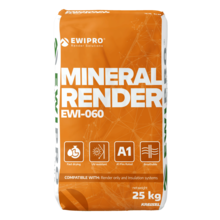
When it comes to choosing a render for your property, the ease of maintenance is an essential consideration. Silicone render, in particular, has gained popularity due to its self-cleaning properties, keeping your building's façade looking pristine and fresh. In this blog, we will discuss the self-cleaning properties of silicone render, its hydrophobic qualities, and how it compares to other render types. We'll also explore how to clean silicone, monocouche, acrylic, and mineral render, and the use of fungicidal washes to keep your building's exterior in top condition.
Self-cleaning properties of Silicone Render
Silicone render is renowned for its self-cleaning properties, thanks to its unique chemistry. Unlike other render types, silicone render is formulated with silicone resins and water-repellent additives that give it hydrophobic characteristics. These properties cause water to bead up on the surface, preventing the absorption of moisture, dirt, and organic growth.
When it rains, the water droplets roll off the surface, picking up dirt and debris along the way. This process, known as the "lotus effect," mimics the self-cleaning mechanism found in nature, such as the surface of a lotus leaf. Dr Wilhelm Barthlott coined the term and revealed 'the lotus’ highly textured surface, which allows air to become trapped within its cavities. This eliminates the ability for condensation to form and enables the wind to move water droplets on the surface, sweeping dirt particles away in the process.' (Naples Garden) The result is a cleaner façade that requires less maintenance, as the rain effectively washes away dirt and contaminants.
Hydrophobic qualities of Silicone Render
Silicone render's hydrophobic qualities not only contribute to its self-cleaning properties but also offer several other advantages. By repelling water, silicone render prevents moisture ingress, which can lead to dampness and structural issues in the long run. This feature also helps the render to dry quickly after rain, reducing the likelihood of algae and mould growth.
Moreover, the hydrophobic nature of silicone render reduces the risk of efflorescence, a common issue with cement-based renders. Efflorescence occurs when salts within the render are drawn to the surface by moisture, creating unsightly white deposits. By repelling water, silicone render minimises the migration of salts, maintaining the façade's appearance and structural integrity.
Hydrophobic surfaces are water-repellent and have a low affinity for water. Water droplets on these surfaces tend to bead up and easily roll off due to the surface's nonpolar nature, creating a high contact angle. Hydrophilic surfaces, on the other hand, are water-attracting and have a high affinity for water. Water droplets on these surfaces spread out, forming a low contact angle. This is because hydrophilic surfaces have polar or charged regions that can form hydrogen bonds with water molecules.
Ways to clean Silicone, Monocouche, Acrylic, and Mineral Render
Despite silicone render's self-cleaning properties, periodic cleaning may still be required to maintain the building's appearance, especially in areas with high levels of pollution or airborne contaminants. The following methods can be used to clean various render types:
Silicone render: As silicone render is self-cleaning, it typically requires little maintenance. However, if cleaning is necessary, use a soft brush and mild detergent to gently remove dirt and debris. Avoid using pressure washers or harsh chemicals, as they can damage the render surface.
Monocouche render: Monocouche render is a through-coloured, single-coat render that can be cleaned using a soft brush and mild detergent. Be cautious when using pressure washers, as excessive pressure may damage the surface. Instead, opt for low-pressure washing techniques to minimise the risk of damage.
Acrylic render: Acrylic render is a flexible, synthetic render that can be cleaned using a soft brush, mild detergent, and water. Like silicone render, avoid using pressure washers or harsh chemicals, as they can cause damage to the surface.
Mineral render: Mineral render is a cement-based render that can be cleaned using a soft brush, mild detergent, and water. You can also use a low-pressure washer, but be careful not to apply too much pressure, as this can damage the render.
Using Fungicidal Wash
Over time, renders may become susceptible to algae, mould, and mildew growth, especially in damp or shaded areas. To effectively clean and prevent organic growth, a fungicidal wash can be used on various render types, including silicone, monocouche, acrylic, and mineral render.
Fungicidal washes are specially formulated cleaning agents that contain active ingredients designed to kill and inhibit the growth of algae, mould, and mildew. These washes not only clean the surface but also provide a protective barrier, reducing the likelihood of future growth.
To use a fungicidal wash, follow these steps:
- Before application, ensure the render surface is free of loose debris, dirt, and dust. Use a soft brush to gently remove any buildup.
- Mix the fungicidal wash according to the manufacturer's instructions. Typically, the wash should be diluted with water, with the concentration depending on the severity of the organic growth. However, EWI Store Fungicidal Wash is designed to be ready to use.
- Apply the fungicidal wash to the render surface using a low-pressure sprayer or soft brush. Be sure to cover the entire area, paying special attention to any heavily affected sections.
- Allow the fungicidal wash to dwell on the surface for the recommended time, as specified by the manufacturer. This dwell time ensures the active ingredients have enough time to effectively kill the organic growth.
- After the dwell time has elapsed, rinse the surface thoroughly with clean water. A low-pressure washer can be used for this step, but take care not to apply excessive pressure that may damage the render.
- Allow the surface to dry completely. The render should now be free of organic growth, and the protective barrier provided by the fungicidal wash will help prevent future occurrences.
To conclude
Silicone render is an excellent choice for property owners seeking a low-maintenance, long-lasting façade solution. Its self-cleaning and hydrophobic properties ensure a clean, attractive appearance with minimal effort. However, if additional cleaning is required, mild detergents, soft brushes, and fungicidal washes can be used to maintain the render's pristine condition.
By understanding the unique characteristics of silicone render and how to care for it, you can enjoy a beautiful, low-maintenance exterior that stands the test of time.




